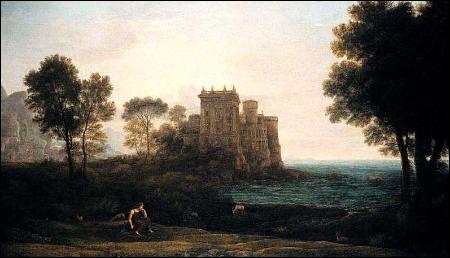 Managed to catch the last day of the Claude exhibition at the Ashmolean yesterday. Over a hundred drawings and etchings and a central room with thirteen paintings. With the exception of some etchings of a firework display, all the works show Claude working steadily away at his trade: depicting poetic landscapes, catching the light of dawn and dusk, creating a poetic mood through the arrangement of trees, classical buildings, banks descending to the water's edge and the water carrying our eye to distant shores. Year after year he did this, sketching in the open air, altering details in the studio, recording real scenes and making other ones up. Whole landscapes could be created using the various elements - towers, branches - roots - in different formulations. The same theme can go through any number of subtly textured variations. Quite often works were sold in pairs: a seascape and a landscape, a dawn scene and a dusk scene. Everything is about ambiance, the depiction of a mood through landscape.
Managed to catch the last day of the Claude exhibition at the Ashmolean yesterday. Over a hundred drawings and etchings and a central room with thirteen paintings. With the exception of some etchings of a firework display, all the works show Claude working steadily away at his trade: depicting poetic landscapes, catching the light of dawn and dusk, creating a poetic mood through the arrangement of trees, classical buildings, banks descending to the water's edge and the water carrying our eye to distant shores. Year after year he did this, sketching in the open air, altering details in the studio, recording real scenes and making other ones up. Whole landscapes could be created using the various elements - towers, branches - roots - in different formulations. The same theme can go through any number of subtly textured variations. Quite often works were sold in pairs: a seascape and a landscape, a dawn scene and a dusk scene. Everything is about ambiance, the depiction of a mood through landscape.Did Claude feel inspiration, a sense of personal expression? Or was it all a job of work, turned out for rich and fashionable patrons? More likely the second, I would say, for this pre-romantic, but his personality remains elusive. He lived and worked in Rome from 1627, and the external life seems to have been uneventful. And the internal life can only be guessed at. Yet he must, surely, have had some deep personal affinity with the natural scenes he saw in his wanderings down the Tiber Valley. The play of light on leaves, the pattern of shadow around tree roots, have never been observed more attentively. The figures are mainly there simply to give scale, and perhaps some kind of narrative vitality, to a scene. They are actors upstaged by the scenery. The relation that matters is the viewer's response to the scene, which is half real, half-theatrical, a matter of planes softly receding, and tones moving through subtle chromatic stages. Subject matter is simply the starting point for exercises in composition and tonal harmony. The sketchbook drawings are free and direct in a way the finished academic paintings cannot be, and yet the paintings, for all their theatricality and artificiality, can sing. The bend of a branch and the contours of a building become part of the mood of a scene: in Landscape with Psyche Outside the Palace of Cupid the whole visible world becomes a natural extension of Psyche's melancholy. In Landscape with a Country Dance an idealised, fantasy world gives us access to a deep serenity. The artificiality is a necessary part of the authenticity. The etchings collection contained an excellent case explaining the processes of that craft. Claude would take an etching through several stages of biting to get the varied stages of shade he wanted. You wouldn't put him up there with Rembrandt as a printmaker, but every now and then a piece has the Claude magic. The show is accompanied by an outstanding catalogue. There is a good piece by Julian Bell in the LRB.